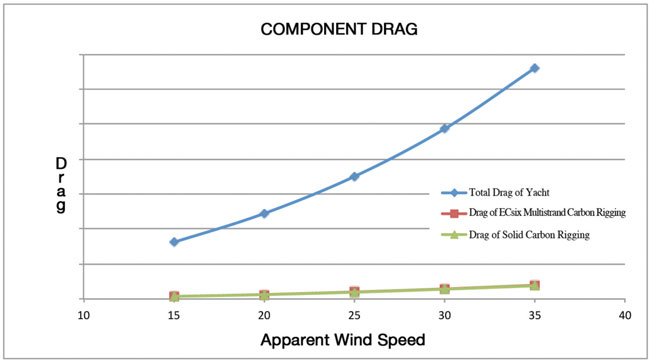

Even aloft it's not only about weight and windage...
Carbon fibre standing rigging is fast becoming commonplace, not just with grand prix-level designs, but also among the world’s ocean record-breakers and increasingly superyachts as well. Advantages in strength, light weight and increased performance are merging now with improved longevity and reliability and therefore longterm costs.
As a manufacturer of both solid and bundled carbon rigging, Future Fibres are always diligent in making sure that customers are best informed on the correct choice to match their particular balance of performance and reliability. Future Fibres’ ECsix continues to offer the best-proven and most durable composite shroud solution. With use across an enormous variety of platforms, widespread acceptance of ECsix has made it today’s de facto choice in carbon rigging. Over 10 years there has not been a single ECsix failure due to age, wear or sailing conditions…
It is the fundamental technology of ECsix that makes it an excellent choice in most applications:
1) Multi-strand cables absorb energy in an impact, so damage doesn’t necessarily migrate through the whole cable. If a single strand is damaged only that strand needs to be repaired. Because of this characteristic, multi-strand cables are remarkably resilient, continuing to support extreme stresses even with several strands severed.
2) Multi-strand cables present no risk of compression failure because the product is flexible and so can bend. However, under similar circumstances a solid cable will, over time, suffer micro-cracking which can eventually lead to failure.
3) Multi-strand cables deliver a significantly stronger connection at spreader and mast wall junctions because of the favourable bending and relief properties of the system.
4) Potential problems in ECsix rigging are easier to identify by removing the outer sheath and conducting a visual inspection, whereas solid cables require X-ray, ultrasound or other expensive inspection technologies, as well as specialised technical expertise. And once identified, the areas to be fixed can be repaired in situ.
5) In terms of portability and practicality, ECsix cables emerge from the factory coiled without fear of kinking or breakage, and can be easily shipped. Similarly, when servicing is needed shipment back to the factory is easier with coiled cable. Solid cables cannot be easily shipped, particularly in long lengths.
6) For most rigs the aerodynamic drag and weight differences between ECsix and solid rod are negligible. But solid rod can be prone to vibration when exposed to conditions of vortex shedding. This vibration not only increases aero drag (a vibration amplitude of one half the diameter is effectively equivalent to a cable twice as big), but it can speed fatigue in metal components and end fittings.
On the performance front, the comparison of solid and bundled systems is interesting. In a recent superyacht rig bid a comparison was run between ECsix and solid carbon rigging which is useful:
- Rigging drag in 15-35kt apparent wind represents only 1.2 per cent of the yacht’s total aero drag.
- The differences in drag between ECsix and solid rod are almost unmeasurable at a couple of tenths of a per cent of the total
- When factoring in that solid rod starts oscillating in this wind range the small advantage in drag of solid rod may only amount to a few fractions of a second over a mile.
That said, for some applications customers demand ultimate performance at the expense of everything else. After some intense development, the introduction of Future Fibres’ Razr line of solid carbon shrouds has been turning heads, with half of the current TP52 fleet already adopting it.
Razr offers only these marginal advantages, but in the ultracompetitive world of the TP52s that marginal advantage can still be enough to decide the first cross.
Terry Hutchinson describes the pros and cons: ‘For the Quantum programme the upside to Razr is windage reduction. The downside is fragility and reliability. With every equipment choice we have to check reliability against performance gain. On a scale of one to 10, with 10 being incredibly reliable, the ECsix rigging was a nine. The new rigging sits somewhere around five…’
This trade-off between immeasurable performance gains and significant reductions in reliability means Razr is only offered for top-end inshore competitions… (and to the best crews). In all other situations, and all offshore applications, ECsix remains the no1 choice – especially in numerous successful laps of the planet in the Volvo Race and the Vendée Globe.
‘As manufacturer of both Razr solid rod and ECsix multi-strand cables, we are confident in the properties and understand the merits of each products,’ said Scott Vogel, Future Fibres’ president and a former America’s Cup winner.
‘But we are similarly aware that to continue the success of the two systems it’s incumbent on us to make sure our customers are always properly informed and then make the right choices for their individual situation.’
Click here for more information on Future Fibres »
We invite you to read on and find out for yourself why Seahorse is the most highly-rated source in the world for anyone who is serious about their racing.
To read on simply SIGN up NOW
Take advantage of our very best subscription offer or order a single copy of this issue of Seahorse.
Online at:
www.seahorse.co.uk/shop and use the code TECH20
Or for iPad simply download the Seahorse App at the iTunes store


